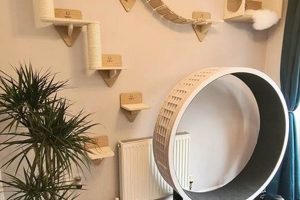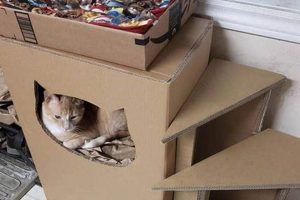The concept involves the independent creation of sheltered enclosures designed to protect feline companions from external environmental conditions. This undertaking commonly utilizes readily available materials and basic construction techniques, resulting in a custom-built refuge for domestic felines that spend time outdoors. A practical illustration includes constructing a weatherproof shelter from repurposed shipping pallets and insulated lining.
Providing a safe and comfortable outdoor shelter is crucial for safeguarding the well-being of cats exposed to the elements. These constructed refuges offer protection from adverse weather such as rain, snow, and extreme temperatures, minimizing the risk of hypothermia or heatstroke. Historically, individuals have sought creative solutions to provide for their pets’ needs, leading to the development of varied approaches for ensuring their comfort and safety.
The subsequent sections will delve into material selection, design considerations, construction methodologies, and essential features for building durable and effective shelters for outdoor cats, ensuring their comfort and safety year-round.
Construction Recommendations for Feline Outdoor Shelters
Effective design and construction are paramount for creating a durable and protective outdoor shelter for cats. Attention to detail ensures a safe and comfortable environment.
Tip 1: Material Selection: Prioritize weather-resistant materials such as treated lumber, durable plastics, or repurposed items like coolers. These materials provide protection from rain, snow, and wind, extending the shelter’s lifespan.
Tip 2: Insulation Implementation: Employ insulation materials like rigid foam or straw to regulate temperature within the shelter. Adequate insulation mitigates temperature extremes, maintaining a comfortable environment for the cat, regardless of external conditions.
Tip 3: Size and Entryway Dimensions: Design the shelter with sufficient space for a cat to stand, turn around, and lie down comfortably. The entrance should be small enough to minimize heat loss and prevent larger animals from entering, ideally around 6-8 inches in diameter.
Tip 4: Weatherproofing Techniques: Employ sealant or caulk to seal gaps and seams, preventing water penetration. Overlapping construction methods and sloped roofing further enhance weather resistance.
Tip 5: Elevated Base Considerations: Elevating the shelter off the ground using bricks or a wooden platform prevents water from pooling and reduces the risk of dampness and mold growth.
Tip 6: Strategic Placement: Position the shelter in a sheltered location, away from prevailing winds and potential flooding. Consider orienting the entrance away from the direction of the strongest winds.
Tip 7: Bedding Material Selection: Provide warm and dry bedding such as straw or shredded paper. Avoid using blankets or towels, which can retain moisture and become breeding grounds for mold.
Adhering to these construction recommendations yields a safe and functional shelter, effectively protecting cats from the elements and contributing to their overall well-being.
The following sections will address ongoing maintenance practices and additional enhancements to optimize feline comfort and shelter longevity.
1. Weatherproof material selection
In the context of independently constructing outdoor shelters for felines, the selection of weatherproof materials is a critical determinant of the structure’s longevity and effectiveness. This selection directly influences the shelter’s ability to protect its occupants from adverse environmental conditions, including precipitation, wind, and temperature fluctuations. The causal relationship is clear: inadequate material choices lead to compromised protection, while appropriate choices ensure a durable and functional shelter. The importance of this component cannot be overstated; it represents the foundational defense against the elements.
Consider, for example, the difference between using untreated wood versus pressure-treated lumber. Untreated wood is susceptible to rot and decay when exposed to moisture, leading to structural failure and rendering the shelter uninhabitable. Conversely, pressure-treated lumber, specifically designed for outdoor use, resists moisture damage and maintains its integrity over extended periods. Similarly, a shelter constructed with tarpaulin or a basic plastic sheet might provide temporary protection but will quickly deteriorate under prolonged exposure to sunlight and extreme temperatures. A more durable option would be to use corrugated plastic, metal roofing, or sturdy composite materials that are designed to withstand long-term outdoor exposure.
The practical significance of understanding weatherproof material selection extends beyond simple construction. It affects the well-being of the animal dependent on the shelter and reduces the frequency and cost of repairs or replacements. Therefore, prioritizing durable, weather-resistant materials is essential for the successful implementation of outdoor feline shelter projects, addressing both the immediate need for protection and the long-term maintenance considerations.
2. Effective thermal insulation
Effective thermal insulation is a critical component of any independently constructed outdoor shelter for felines. The primary function is to mitigate temperature extremes within the shelter, maintaining a habitable environment for the animal. Without adequate insulation, the internal temperature of the shelter will closely mirror the external ambient temperature, rendering it ineffective during periods of severe cold or heat. Therefore, thermal insulation directly impacts the shelter’s ability to protect the cat from hypothermia, frostbite, heatstroke, and general discomfort, significantly influencing its overall well-being.
The implementation of thermal insulation can involve several strategies. One common approach involves incorporating rigid foam insulation boards within the walls and roof of the structure. For example, a shelter built with a layer of 1-inch thick rigid foam insulation will exhibit significantly better temperature regulation compared to an uninsulated structure of the same design. Alternative methods include using natural materials such as straw or tightly packed shredded paper as insulation. While these materials may offer a less uniform level of insulation, they can be more readily available and cost-effective. Regardless of the method, proper installation, ensuring minimal gaps and air leakage, is vital to maximizing the insulation’s effectiveness. Furthermore, the choice of insulation material should consider factors such as moisture resistance and non-toxicity to avoid adverse effects on the feline occupant.
In conclusion, thermal insulation represents an essential element in constructing functional outdoor shelters. Prioritizing effective insulation addresses immediate environmental protection needs and has implications for the long-term health and comfort of the animal. While challenges may arise regarding material selection and installation techniques, the benefits of a well-insulated shelter far outweigh the associated complexities. Proper understanding and application of insulation principles are integral to constructing shelters that genuinely serve their intended purpose.
3. Appropriate size/dimensions
The dimensional specifications of independently constructed outdoor feline shelters are critical to their overall effectiveness and utility. The interior volume must be optimized to balance thermal efficiency and feline comfort. Dimensions deviating significantly from established parameters can compromise the shelter’s primary purpose.
- Internal Space Considerations
The dimensions of the internal space directly affect the thermal efficiency of the shelter. An excessively large space requires more energy to heat and maintain a comfortable temperature during cold weather. Conversely, an inadequately sized space can induce stress and discomfort for the occupant, discouraging its use. Optimal dimensions should provide sufficient room for a cat to stand, turn around, and lie down comfortably without excessive heat loss.
- Entrance Size and Shape
The dimensions of the entrance must be carefully considered. A large entrance allows for easy access but also facilitates heat loss and potentially permits entry by larger animals. An excessively small entrance may deter use. A balance must be struck, typically favoring a small, low entrance (approximately 6-8 inches in diameter) to minimize heat loss while remaining accessible to cats. Shape can also play a role; a circular or oval entrance can reduce drafts.
- Number of Occupants
The intended number of occupants influences the necessary dimensions. A shelter designed for a single cat requires less space than one intended for multiple felines. Overcrowding can lead to stress, competition for resources, and increased risk of disease transmission. Space should be allocated proportionally to the expected number of inhabitants, accounting for individual space requirements and potential social dynamics within the group.
- Portability and Placement
The external dimensions of the shelter affect its portability and placement. An excessively large or heavy structure may be difficult to move or position in optimal locations. Dimensions should be compatible with the available space and allow for relatively easy relocation if necessary. Considerations should include doorway widths, vehicle transport capabilities, and potential obstruction from landscaping or other outdoor features.
In summation, dimensional considerations are a pivotal aspect of successfully building outdoor feline shelters. Balancing internal space with external practicality, and adapting to the intended number of occupants and the shelter’s intended location, ensures a structure that is both functional and comfortable for its feline inhabitants. Careful planning and adherence to dimensional guidelines are essential for maximizing the effectiveness and longevity of the shelter.
4. Strategic placement outdoors
The efficacy of any independently constructed outdoor feline shelter hinges significantly on its strategic placement within the external environment. This factor directly influences the shelter’s ability to provide effective protection from weather elements, potential predators, and other environmental stressors. The causal relationship is straightforward: a poorly located shelter offers diminished protection, while a strategically placed shelter maximizes its protective capabilities. Integrating strategic placement into the design and construction phases represents a critical aspect of ensuring the shelter’s function.
Consider the example of placing a shelter directly in the path of prevailing winds. This placement exposes the entrance to harsh weather, reducing the shelter’s ability to maintain a stable internal temperature and potentially discouraging feline occupancy. Conversely, positioning the shelter against a building wall or beneath the overhang of a roof shields it from wind and precipitation, creating a more stable and secure microclimate. Similarly, placing the shelter in an area prone to flooding renders it unusable during periods of heavy rainfall. Elevating the shelter on a platform or selecting a location on higher ground mitigates this risk. Moreover, positioning the shelter near potential food sources or areas frequented by cats encourages its adoption and regular use. Conversely, placing it in a high-traffic area or near known predator habitats can deter its use and compromise the animal’s safety.
In summary, strategic placement is an indispensable element in maximizing the benefits of outdoor feline shelters. It enhances protection from environmental hazards, promotes feline occupancy, and contributes to the overall success of the project. Challenges associated with identifying optimal locations can be addressed through careful site assessment, consideration of local weather patterns, and observation of feline behavior. Integrating placement strategies into the design phase ensures a functional and effective outcome, optimizing the shelter’s role in safeguarding feline well-being.
5. Maintenance and upkeep
The long-term effectiveness of independently constructed outdoor feline shelters directly correlates with consistent maintenance and upkeep practices. These practices prevent deterioration, ensure continued functionality, and safeguard the health of the occupant. Failure to implement a regular maintenance schedule results in compromised structural integrity, potential health hazards, and, ultimately, the diminished utility of the shelter. The relationship is causal; neglecting maintenance leads to predictable negative consequences, while consistent attention extends the shelter’s lifespan and protects its inhabitant.
A practical example illustrates this connection. Consider a shelter built with durable materials but left unmaintained. Over time, debris accumulates inside, creating unsanitary conditions that can harbor parasites or bacteria. Additionally, weather exposure degrades the materials, leading to cracks or leaks. A simple routine of weekly cleaning removes debris, and seasonal inspections identify and address minor damages before they escalate into major structural issues. Regularly replacing bedding material ensures a dry and warm environment, minimizing the risk of respiratory problems. Addressing issues like warped wood or damaged insulation prevents further degradation and maintains the shelters insulating properties. Furthermore, annual treatments with pet-safe wood preservatives can protect against rot and insect infestation, extending the shelters service life significantly.
In conclusion, maintenance and upkeep are not merely supplementary tasks but rather integral components of a successful “outdoor cat house diy” project. Consistent attention to these practices prevents degradation, ensures continued functionality, and promotes the feline occupants well-being. Neglecting this aspect undermines the initial investment of time and resources, ultimately diminishing the shelters effectiveness. Addressing potential challenges through regular inspections, cleaning, and preventative repairs ensures the long-term utility of these constructed refuges, aligning with the broader goal of providing safe and comfortable outdoor environments for domestic felines.
Frequently Asked Questions Regarding Outdoor Feline Shelters
This section addresses common inquiries and misconceptions regarding the independent construction of shelters designed for outdoor cats, offering concise and factual answers.
Question 1: What constitutes suitable material for constructing outdoor feline shelters?
Acceptable materials include treated lumber, durable plastics, and repurposed items such as coolers or storage containers. The chosen material must exhibit weather resistance and structural integrity to withstand external environmental factors.
Question 2: How does insulation contribute to the functionality of outdoor feline shelters?
Insulation regulates internal temperature, protecting the animal from extreme heat and cold. Effective insulation minimizes the risk of hypothermia, heatstroke, and general discomfort, rendering the shelter habitable year-round.
Question 3: What are the recommended dimensions for an outdoor feline shelter?
The dimensions should provide sufficient space for a cat to stand, turn around, and lie down comfortably. The entrance should be small enough to minimize heat loss and prevent entry by larger animals, typically around 6-8 inches in diameter.
Question 4: Where is the optimal placement for an outdoor feline shelter?
The shelter should be located in a sheltered area, away from prevailing winds and potential flooding. Positioning the entrance away from the strongest winds further enhances protection.
Question 5: What maintenance is required for outdoor feline shelters?
Regular cleaning to remove debris and seasonal inspections to identify and address any damages are essential. Replace bedding material periodically to maintain a dry and warm environment. Treat wooden structures with pet-safe preservatives to prevent rot.
Question 6: What type of bedding is appropriate for outdoor feline shelters?
Straw or shredded paper is recommended due to their superior moisture-wicking properties. Avoid using blankets or towels, which can retain moisture and potentially harbor mold and bacteria.
The construction of outdoor feline shelters is an investment in the well-being of animals exposed to environmental elements. Consistent upkeep ensures sustained functionality.
The subsequent segment will explore advanced considerations for improving the efficiency and longevity of independently constructed shelters.
Conclusion
The preceding exploration of “outdoor cat house diy” has underscored its vital role in safeguarding the health and comfort of outdoor cats. Crucial aspects, including material selection, dimensional considerations, placement strategies, and maintenance protocols, directly influence the effectiveness of these independently constructed shelters. Prioritizing weatherproof materials, implementing adequate insulation, ensuring appropriate dimensions, strategically positioning the structure, and adhering to regular upkeep schedules are paramount for achieving a durable and functional refuge.
The commitment to providing safe and reliable outdoor shelters reflects a fundamental responsibility to protect vulnerable animal populations. Continued innovation in design and material usage, combined with widespread adoption of best practices, will further enhance the ability to mitigate environmental risks and improve the lives of felines reliant on these structures. The collaborative effort of individuals and communities dedicated to animal welfare remains essential in ensuring that outdoor cats have access to adequate shelter and protection.







